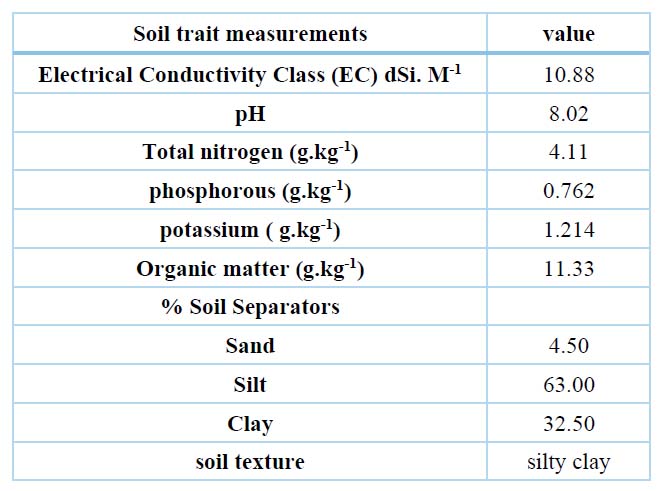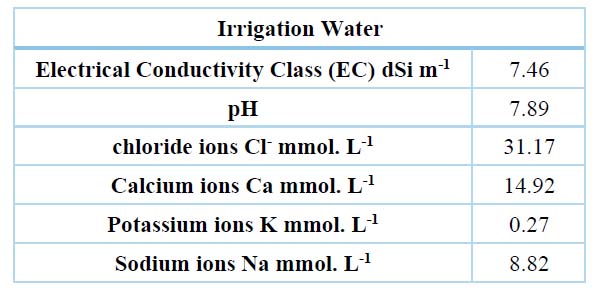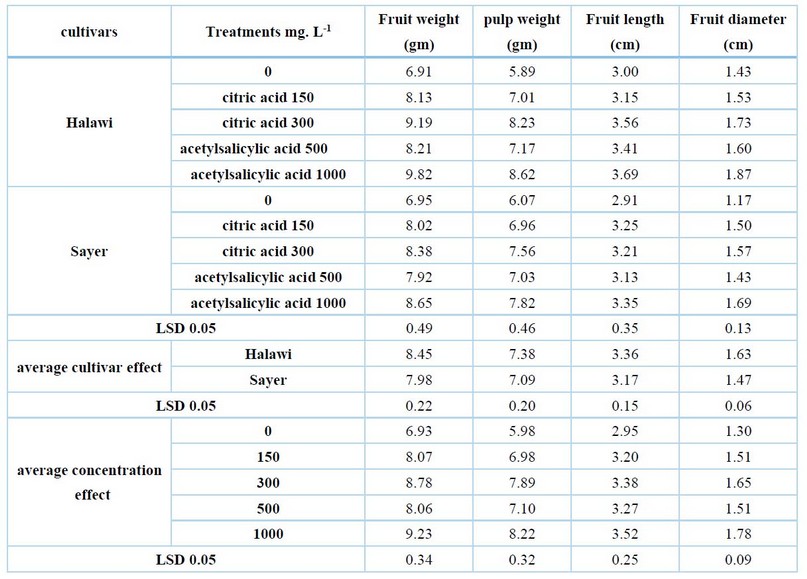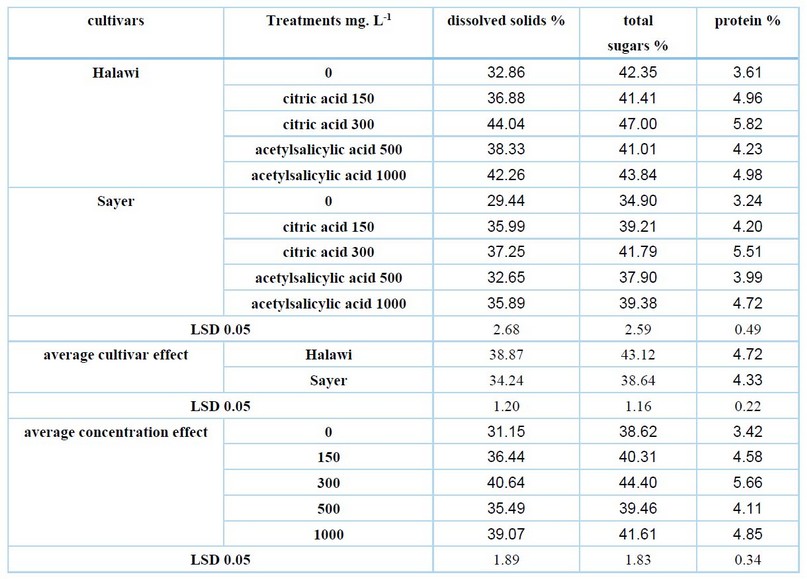2023.08.02.88
Files > Volume 8 > Vol 8 No 2 2023
Effect of spraying the acetylsalicylic acid and citric acid on some physical and chemical characteristics of date palm two cultivars Halawi and Sayer
1.2 Department of Horticulture, College of Agricultural, University of Basrah, Iraq;
* Correspondence: [email protected]; Tel.: +9647707099690
Available from: http://dx.doi.org/10.21931/RB/2023.08.02.88
ABSTRACT
This study was conducted in an orchard in Basra Governorate during the 2020 growing season, with the aim of the effect of spraying the antioxidants acetylsalicylic acid and citric acid on some physical and chemical characteristics of two date palm cultivars Phoenix dactylifera L. (Halawi and Sayer) in improving the chemical and physical properties of the fruits. The experiment included five-factor treatments, which are the comparison treatment and two concentrations of citric acid 150, 300 mg.L-1 and two concentrations of acetylsalicylic acid 500 and 1000 mg.L-1, the floral spikes were sprayed twice, the first spraying a month after pollination and the second spray 15 days after the first spray. The results demonstrated that spraying with two acids led to a significant increase in all studied traits, sprayed with salicylic acetylcholine at a concentration of 1000 mg. mg.L-1 and spraying with citric acid 300 mg. mg.L-1 significant increase in yield, while spraying with distilled water gave the lowest value for the studied traits, the binary interaction between acetylsalicylic acid at a concentration of 1000 mg.L-1 and Halawi cultivar significantly outperformed in all the traits included in the study.
Keywords: Acetyl, citric acid, date palm, Halawi, Sayer.
INTRODUCTION
The date palm, Phoenix dactylifera L., is a monocotyledonous plant and the first Iraq tree. It is one of the evergreen fruit trees in the palm family Arecacea. Its cultivation is spread in the tropics, and the Arabian Gulf region is considered the most expansive area for date palm cultivation1. The area planted with date palms in Iraq is estimated at 123.230 hectares, and the number of fruit trees in it is about 7263472 palm trees, with a production rate of 676.111 tons2.
Recently, attention has been paid to palm cultivation due to the great importance of this tree to humans in terms of nutritional, environmental, economic and social aspects. The fruits of the palm are high-energy fruits and a good source of some vitamins, especially the vitamin B group, as well as its content of mineral elements, proteins, carbohydrates, fats, and others3,4.
Soil salinity is one of the factors affecting and determining the growth and productivity of plants and the quality of fruits of many horticultural crops, including the date palm. However, it is considered one of the most tolerant fruit trees to salt stress, as its tolerance greatly exceeds the patience of many other fruit trees. However, its productivity is less with the increase of soil salinity in the area of root spread; it is not recommended to plant date palm in lands whose salinity exceeds (7000) ppm in the area of root spread, but the percentage of salinity in the surface layer may exceed that5.
The increase in soil salinity makes us face a real problem that requires some methods to be taken to treat it. Among these methods that make the plant more tolerant of salt stress is that there is a correlation between salicylic acid and endurance of salt stress, as this acid activates many enzymes and armed processes in the plant in addition to increasing the protein content in plant cells that makes the plant have the ability to face salt stress6.
Citric acid is the most critical carboxylic acid and one of the non-enzymatic antioxidants that work to eliminate free radicals. It is the primary substrate in the Krebs cycle (TAS) reactions and the most effective in producing energy in mitochondria. It helps form many compounds and components that contribute to synthesizing plant tissues And building their different parts. These compounds include proteins, carbohydrates, fats, and others. Due to the lack of previous studies in Iraq that include the use of acetylsalicylic acid and citric acid and their effect on the physical, chemical and productive characteristics of the fruits of the Al-Sayer and Al-Halawi date palms, and the importance of the date palms planted in dry and semi-arid lands, which are affected by varying degrees of salinity, so this study aims to:
Several treatments of acetylsalicylic acid and citric acid at different concentrations to improve the fruit characteristics of Al-Sayer and Al-Halawi cultivars grown in the conditions of Basrah Governorate.
MATERIALS AND METHODS
The study was conducted in one of the private orchards in the Shatt Al-Arab district, Al-Jazirah region of Basra Governorate, during the 2020 planting season. The soil of the orchard was analyzed by taking samples at a depth of (0-60) cm. Table (1) shows some physical and chemical properties of field soil, and Table (2) shows some chemical characteristics of the irrigation water for the orchard.

Table 1. Physical and chemical properties at (0-60) cm depth of orchard soil.

Table 2. Some characteristics of water for the study site.
Fifteen date palm trees of the Al-Halawi cultivar and 15 trees of the Al-Sayer cultivar were selected, almost identical in age, height and vegetative growth as much as possible, free of disease, and at the age of 14, six Floral spikes were left on each palm. The trees were vaccinated on 23/3 with Al-Ghanami green pollen; the inflorescences were sprayed with aqueous solution of citric acid at a concentration of 150 and 300 mg. L-1 and acetylsalicylic acid (aspirin) when focusing of 500, 1000 mg. L-1 by hand sprayer with a capacity of 2 liters in the early morning and at a rate of two sprays, the first spray after two weeks of vaccination and the second spray three weeks after the first spray,
The diffusion substance Tween20 concentration of 0.1% as it had been added to solutions used to reduce the surface tension of water on the leaves. As for the comparison treatment, it was prepared from distilled water only. The samples were taken for the fruits in the Khalal stage.
Physical characteristics of the fruits
Fruit weight and fleshy layer weight (gm): Twenty-five fruits were taken randomly from each repeater, and the consequence was recorded using an electronically sensitive scale. Sartorious type. Then, the seeds were removed from the fruits, and the weight was recorded. As for the weight of the pulp of the fruit, it was calculated by subtracting the importance of the seed from the weight of the fruit. The length and diameter of the fruit: The same fruits' diameter and length were measured by the measuring foot (Vernier caliper) in cm units.
Chemical properties
Total dissolved solids (%): The percentage of total soluble solids (TSS) of fruits was estimated using a manual refractometer, after which the reading was adjusted at (20°C) based on the method of 8. As for estimating total sugars (%) at the interstitial stage by the Len and Inon method, as in9. Protein in fruits (%) The percentage of protein in fruits was estimated after digesting the plant samples according to 10. Then, the nitrogen concentration in the plant samples was estimated by the Micro Kildhal steam distillation apparatus according to the method described in 11. The protein content of fruits was calculated based on their nitrogen content according to the following relationship:
Protein in fruits (%) = nitrogen in fruits (%) x 6.25
The experiment was a factorial experiment with three replicates using a randomized complete block design (RCBD). Statistical analysis of the experiment data was conducted using the statistical program (Genstate v 12), and the means were compared using the least significant difference (LSD) test at a probability level of 0.05 by 12.
RESULTS
Table (3) Demonstrates the effect of spray with acetylsalicylic acid and citric acid on Al-Halawi and Al-Sayer cultivars and the interaction between them on the physical characteristics of the fruit at the Al-Khallal stage. The Halawi cultivar was significantly superior in all the characteristics of the yield components represented in the fruit weight, pulp weight, length and diameter characteristics. Al-Halawi cultivar, the highest values were recorded for the attributes mentioned above (8.45, 7.38) gm, (3.36, 1.63) cm sequentially, compared to the Al-Sayer cultivar, which reached (7.98, 7.09) gm, (3.17, 1.47) cm sequentially. The interaction between the two factors of the study, spraying treatments and cultivars, had a significant impact on the properties components of the yield studied above.

Table 3. Effect of spraying treatment with acetylsalicylic acid and citric acid on the physical characteristics of the fruit and the interaction between them for the Halawi and Al-Sayer cultivars / Khalal stage.
Al-Halawi cultivar and spraying treatment with acetylsalicylic acid exceeded the concentration of 1000 mg. L-1 recorded the highest values of (9.82, 8.62) g, (3.69, 1.87) cm, compared with the comparison treatment for Al-Sayer variety, which recorded the lowest values (6.95, 6.07) g, (3.25, 1.50) cm, respectively. Then, this treatment was followed by spray effect citric acid 300 mg.L-1 for the Al-Halawi cultivar, which did not differ significantly between them in the fleshy layer's characteristics and the fruit's length. The reason for the superiority of the Halawi cultivar over the Al-Sayer variety may be attributed to the fact that the content of the internal hormones (auxin, gibberellin and cytokinin) is higher than the Al-Sayer cultivar, which led to growth and therefore higher weight. The fruit, its length and diameter may be attributed to the genetic nature of the variety, as for the role of acetylsalicylic acid in increasing the yield characteristics to increase cell divisions, which leads to increased fruit growth, in addition to increasing the effectiveness of nucleic acids, DNA and RNA13. It also reduces the concentration of ABA and increases the efficiency of photosynthesis and physiological processes that result in increased absorption of mineral elements and an increase in the concentration of plant hormones such as auxins, gibberellins and cytokinins that affect the process of cell division, elongation and expansion, which reduces the speed of entry of fruits into the ripening stage. Which necessarily reflects the dimensions of the fruit and its weight. As for the effect of citric acid, it works as an auxin, stimulating cell division and expansion and thus increasing the growth of fruits15. In addition, it plays a significant role in preventing the sudden change in the pH, which leads to an increase in the activation of enzymes and metabolic activities in the plant cell, and this encourages increased fruit growth and improved physical properties of fruit16.
Table (4) results indicate significant differences between Al-Halawi and Al-Sayer cultivars in total soluble solids, sugars, and protein. Al-Halawi cultivar significantly outperformed and gave the highest rate of these traits (38.87%, 43.12%, 4.72% compared to Al-Sayer cultivar (34.24%, 38.64, 4.33 %, respectively. The same Table shows that spraying with acetylsalicylic and citric acids significantly affected the studied characteristics (total soluble solids, total sugars and protein). As the spraying treatment with citric acid exceeded 300 mg. L-1 amounted to (40.64%, 44.40%, and 5.66% compared with the comparison treatment, which gave the lowest measurements for these traits (31.15, 38.62, 3.42) %, respectively.

Table 4. Effect of spraying treatment with acetylsalicylic acid and citric acid on the chemical characteristics of the fruit and the interaction between them for Halawi and Al-Sayer cultivars / Khalal stage.
The treatment of spraying with acetylsalicylic acid at a concentration of 1000 mg, L-1 was also superior., which did not register a significant difference with the spray treatment with citric acid 300 mg. L-1 in total dissolved solids (TDS) ratio, which in turn outperformed the control treatment. The interactions between the study's two factors significantly affected several chemical properties (total soluble solids, total sugars and protein).
The highest rate of soluble solids, total sugars and protein was obtained in the Halawi cultivar when spraying with citric acid at a concentration of 300 mg. L-1, which amounted to (44.04, 47.00, 5.82)%, compared to the control treatment for the Al-Sayer brand (29.44, 34.90, 3.24) %.
We note the superiority achieved in the Halawi variety in increasing the percentage of total soluble solids and protein, which may be attributed to the higher rate of total sugars of the Halawi compared to the Al-Sayer or because of the genetic nature of the variety following the study of17.
DISCUSSION
The improvement of some of the chemical properties of the fruit may be because acetylsalicylic acid has an influential and essential role in increasing the antioxidants when exposed to harsh environmental conditions such as drought, salinity and high temperatures, or it works to reduce the concentration of abscisic acid (ABA) and raise the efficiency of photosynthesis and physiological processes that result in an increase Absorption of mineral elements and increase the concentration of plant hormones such as auxins, gibberellins and cytokinins18.
As for citric acid, it has a positive effect in reducing environmental influences and improving the condition of the plant by increasing the stimulation for photosynthesis and thus increasing the manufacture and accumulation of carbohydrates in the plant, which is positively reflected in the collection of soluble solids in the fruits and an increase in the percentage of sugars that accumulate in the fruits19. This result agrees with 20,21.
CONCLUSIONS
The above results showed that acetylsalicylic and citric acid could be used as improvers to increase yield and stress tolerance for date palms planted in the Basra region.
Funding
This research received no external funding.
Institutional Review Board Statement
Not applicable.
Informed Consent Statement
Not applicable.
Acknowledgments
All appreciation and thanks go to the Biotechnology Lab at the Department of Horticulture and Landscaping and to Dr. Assem for supporting this work by conducting experiments on his farm.
Conflict of interest
All researchers participating in this research acknowledge no conflict of interest.
REFERENCES
1. Al-Jubouri, Hamid Jassim. The importance of date palm trees, State of Qatar. Training course on tissue culture applications in improving plant production, Arab Organization for Agricultural Development - Doha - Qatar. 2002; 25-1.
2. Arab Organization for Agricultural Development. The current situation of palm and date production in the countries of the Arab Mashreq region. Journal of Agriculture and Development in the Arab World. 2016; 3 (2): 11-19.
3. Aljaloud, S., Colleran, H. L., & Ibrahim, S. A. . Nutritional value of date fruits and potential use in nutritional bars for athletes. Food and Nutrition Sciences, 2020; 11(06), 463.
4. Harkat, H., Bousba, R., Benincasa, C., Atrouz, K., Gültekin-Özgüven, M., Altuntaş, Ü., ... & Özçelik, B. . Assesses biochemical composition and antioxidant properties of Algerian date palm (Phoenix dactylifera L.) seed oil. Plants, 2022; 11(3), 381.
5. United Nations Development Program . The Arab Republic of Egypt - Kenana - Community Development Portal. 2006.
6. Kumar, P., Dube, S. D., and Chauhan, V.S. . Effect of salicylic acid on growth, development and some biochemical aspects of soybean (Glycine max L. Merrill). Ind. J. Plant Physiol., 1999; 4: 327-330.
7. Verma, S.K. and M.A. Verma . Textbook of plant physiology, biochemistry and biotechnology 10th ed. s. Chand and company. LTD. Ram Nager, New Delhi, 2008; India: 194-196.
8. Shirokov, E.P. Practical course in storage and processing of fruit and vegetables . USDA / NSF .Washington , DC, USA. 1968.
9. Abbas, Moayad Fadel and Mohsen Jallab Abbas . Care and storage of practical fruits and vegetables. Dar Al-Hikma Press - University of Basra - Iraq. 1992.
10. Cresser,M.S. and Parsons, J.W.Sulphuric-Perchloric acid digestion of Plant Material for the Determination of nitrogen,phosphorus ,potassium , calcium and magnesium . Anal. Chem. Acta., 1979;109:431-436.
11. Page, A. L., R. H. Miller and D. R. Keeney. Methods of soil analysis. Part 2.Chemical and microbiological properties. ASA Madison. 1982.
12. Al-Rawi, Khasha Mahmoud and Abdul-Aziz Muhammad Khalaf Allah . Design and analysis of agricultural experiments. Dar Al-Kutub for Printing and Publishing, Mosul / Iraq: 2000; 448 p.
13. Hao, L.; Zhau, L. Xu, X.; Cao, J. and Xi, T. The role of salicylic acid and carrot embryo genic callus extract in somatic embryogenesis of naked out (Aven nuda). Plant Cell, Tissue and Organic Culture, 2006; 85:109-133.
14. Sah, S. K., Reddy, K. R., & Li, J. Abscisic acid and abiotic stress tolerance in crop plants. Frontiers in plant science, 2016; 7, 571.
15. El-Khawaga, A.S. Effect of Anti-salinity agents on growth and fruiting of different date palm cultivars .Asian, J. Scie., 2013;5(1):65-80.
16. Al-Saadi, H.A. and A.H. Al-Moussawi . Practical plant physiology. Department of Biology, College of Science, University of Basra, 1980; Press: 348.
17. Al-Rawi , A. A. H. Fertilization of Date palm Tree phoenix dactylifera in Iraq . proceedings of the first international conference of date palm, Al-Ain ,1998; 320-328.
18. Ganova, I., Ďurkovič, J., Hladká, D., & Lukáčik, I. Changes in stomatal characteristics and photochemical efficiency during leaf development in six species of Sorbus. Photosynthetica, 2012; 50(4), 635-640.
19. Abd El-al, Faton S. Effect of urea some organic acids on plant growth, fruit yield and its quality of sweet pepper (Capsicamannuns). Res . J. Agri. And Biol. Sci. 2009; 5(4):372-379.
20. El-Badawy,H.E.M. Effect of some antioxidants and micronutrients on growth, leaf mineral content, yield and Fruit quality of canino apricot trees .J.Applied,Sci.Res., 2013; 9(2):1128-1137.
21. Abdullah, Abdulaziz Abdullah . The effect of spraying citric acid on the green growth of bean sprouts planted in southern Iraq. Basra Research Journal (Operations). 2013; 39(1): 1-12.
Received: May 15, 2023/ Accepted: June 10, 2023 / Published: June 15, 2023
Citation: Auda, M S.; Hzaa, A Y L. Effect of spraying the acetylsalicylic acid and citric acid on some physical and chemical characteristics of date palm two cultivars Halawi and Sayer. Revis Bionatura 2023;8 (2) 88. http://dx.doi.org/10.21931/RB/2023.08.02.88
